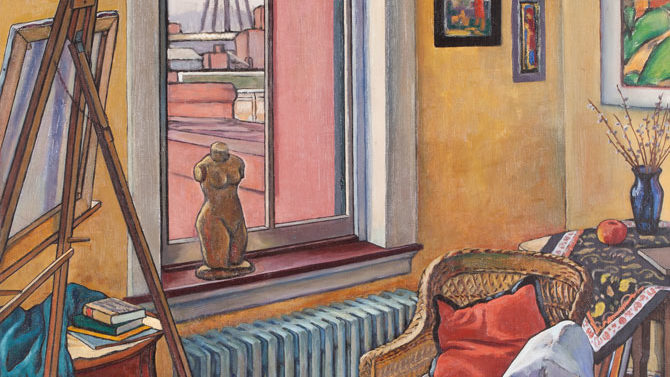Offering a cool and reflective space to retreat from the July heat, the Georgia Museum of Art has three new collections temporarily on view. All exhibitions will be celebrated during 90 Carlton: Summer, the museum’s quarterly reception featuring gallery activities, door prizes and refreshments, on Friday, July 20 from 5:30–8:30 p.m.
CENTRAL TO THEIR LIVES: Women artists have been severely underrepresented in major permanent collections across the U.S. and Europe throughout history, to such an extent that any accusations of women appearing as the muses on canvases more frequently than the names on wall placards seems beyond plausible. On tour from Spartanburg, SC, “Central to Their Lives: Southern Women Artists in the Johnson Collection” takes a step towards correcting the canon by examining the hardships and achievements of artists from one of the most overlooked regions of the country. On view through Sept. 23, the exhibition selects 42 women artists who were active between the late 1890s and early 1960s, a pivotal time characterized by redefining women’s social, cultural and political roles.
Thankfully, the exhibition takes the time to include biographical information on each artist, sharing how many were influenced by complex challenges not limited to prescribed gender roles, access to education, racism and poverty. Virginia painter Nell Blaine, who once wrote, “Art is central to my life. Not being able to make or see art would be a major deprivation”—a heartfelt line that inspired the exhibition’s title—succeeded in creating art despite visual impairment, polio and paralysis. Anna Vaughn Hyatt Huntington, whose bronze “Yawning Tiger” sculpture is on view, went on to establish the nation’s first public sculpture park at Brookgreen Gardens in South Carolina, despite little formal instruction in an art form that had often been assumed as too physically demanding for a woman to master. Gracing the cover of Flagpole this week, Lois Mailou Jones’ oil painting from 1935, “Africa,” demonstrates the former Howard University faculty member’s efforts at exploring her own heritage while contradicting contemporary racial stereotypes.
“Central to Their Lives” includes paintings, drawings and sculptures by artists including Kate Freeman Clark, Minnie Evans, Anne Goldthwaite, Clementine Hunter, Ella Sophonisba Hergesheimer, Augusta Savage, Alma Thomas and Elizabeth O’Neill Verner.
Presenting movie adaptations of classic novels, the Southern Women Artists Film Series will include 7 p.m. screenings of Carson McCullers’ The Heart is a Lonely Hunter on July 12, Flannery O’Connor’s Wise Blood on July 19 and Harper Lee’s To Kill a Mockingbird on July 26. Additional events for “Central to Their Lives” include a Family Day on July 14, an Artful Conversation on Teresa Pollak’s painting “Art Studio” on July 18, a Toddler Tuesday on July 24 and a Tour at Two on Sept. 5.
BLOOM WHERE YOU’RE PLANTED: With an emphasis on portraiture, still life and landscape, “Bloom Where You’re Planted: The Collection of Deen Day Sanders” beautifully portrays a slice of American life. Most prominently, the heavy presence of botanicals and outdoor scenes demonstrates Sanders’ devout love of the natural world. In addition to serving as president of the Garden Club of Georgia and National Garden Clubs, Inc. and vice president of the World Association of Floral Artists, she has been on the boards of the Atlanta Botanical Garden and U.S. Botanic Garden. She has also supported the State Botanical Garden of Georgia since its establishment over 50 years ago and helped develop plans for the Cecil B. Day Chapel, a peaceful venue in the woods named for her late husband, as well as an accessibility path in the Shade and Native Flora Gardens in memory of her late son, Burke Day.
Somehow, Sanders managed to find time around her philanthropic pursuits to build one of the most notable art collections in the state. On view through July 29, the exhibition includes paintings, furniture and porcelain pieces that exemplify major trends in American art from the 19th to early 20th centuries. A perplexing number of portraits—such as those by Charles Curran, Seymour J. Guy, George Lambdin and Thomas Sully—depict women and children reading, reflecting a societal shift as reading literature for leisure or educational purposes became more common in privileged spheres. While many of the still-life paintings are timeless odes to flowers in full bloom, some incorporate unexpected subjects, like ripe raspberries from August Luax and birds’ nests from Severin Roesen. Multiple landscape artists, like Albert Bierstadt, Herman Ottomar Herzog and Thomas Moran, attempt to capture the vast horizons and uncharted wilderness of the American West.
A LEGACY OF GIVING: Recognized on campus as the namesake behind UGA’s Terry College of Business, alumnus Herman Terry and wife Mary Virginia Terry made a generous donation in 1990 that held the record of being the largest private gift in UGA’s history. Over the past several decades, their contributions have endowed numerous faculty chairs, research programs, scholarships and other endeavors not limited to academia.
On view through Aug. 5, “A Legacy of Giving: C. Herman and Mary Virginia Terry” displays a collection of 14 paintings and works on paper by American and French artists that were gifted to the museum in 2017. The donation reflects two of Mary Virginia’s greatest philanthropic interests—education and the arts—and she hopes the pieces will make a positive impact on students’ lives. Originally collected to decorate the couple’s home, the gift includes watercolors by Gifford Beal, Winslow Homer, John Stuart Ingle, John Singer Sargent and Andrew Wyeth; oils by Armand Guillaumin, Ernest Lawson, Albert Lebourg, John Henry Twachtman, Maurice Brazil Prendergast and John Leslie Breck; and pastels by Childe Hassam and Laura Coombs Hills.
Like what you just read? Support Flagpole by making a donation today. Every dollar you give helps fund our ongoing mission to provide Athens with quality, independent journalism.










